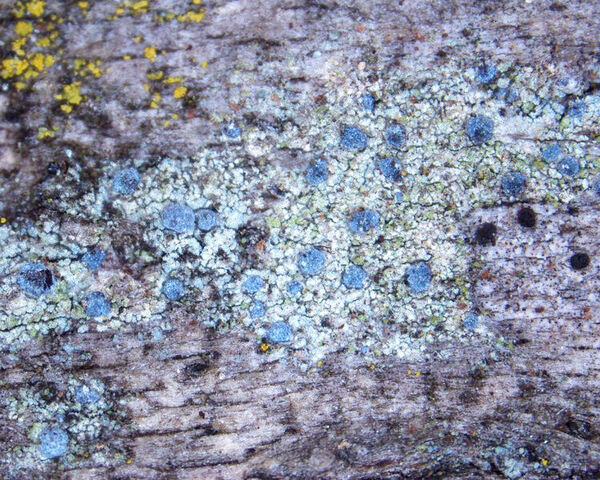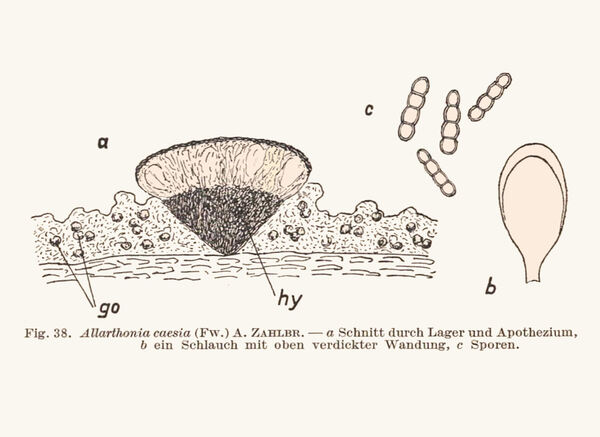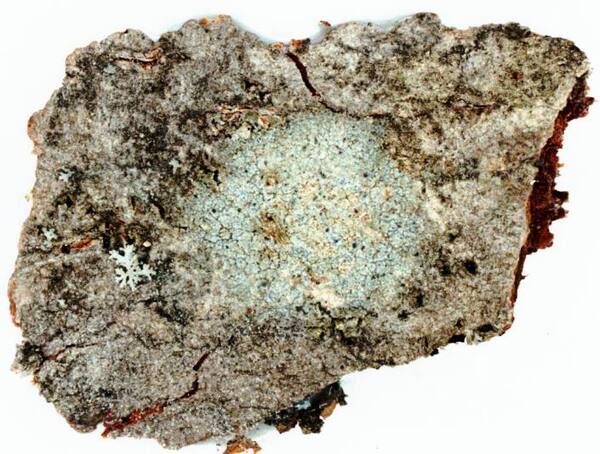Chrysothrix caesia (Flot.) Ertz & Tehler
Fungal Divers., 49: 53, 2011. Basionym: Coniangium caesium Flot. in Körb. - Syst. Lich. Germ.: 295, 1855.
Synonyms: Allarthonia caesia (Flot.) Zahlbr.; Arthonia caesia (Flot.) Körb.
Description: Thallus crustose-subleprose, thinly episubstratic, yellowish green to greyish-green, sometimes with a faintly bluish hue, continuous or locally ± areolate, granular to leprose, the leprose parts continuously sorediate, usually without a distinct prothallus, covered with very thin, acicular crystals of zeorin in old herbarium specimens. Apothecia rather rare, biatorine, more or less round, 0.2-0.4(-0.7) mm across, at first immersed in the thallus, with a dark brown to black, but densely bluish-grey pruinose, flat to slightly convex disc, emarginate. Proper exciple poorly developed, very thin, reddish brown; epithecium reddish brown c. 10 μm high; hymenium colourless to yellowish brown, 60-75 μm high; paraphysoids rather thin, sparingly branched and anastomosing, not or only slightly thickened at apex; hypothecium dark red-brown, conical, up to 60 μm high. Asci 8-spored, clavate, with a K/I+ blue layer between the two walls which is thicker in the apical part, becoming more diffuse downwardly. Ascospores 3-septate, slightly constricted in the middle, hyaline, more or less bacilliform, 15-22(-24) x 4-6 μm. Photobiont chlorococcoid. Spot tests: thallus K- or K+ pale yellow, C-, KC- or KC+ pale yellow, P-, UV-. Chemistry: usnic acid, zeorin.
Growth form: Crustose
Substrata: bark
Photobiont: green algae other than Trentepohlia
Reproductive strategy: mainly sexual
Commonnes-rarity: (info)
Alpine belt: absent
Subalpine belt: absent
Montane belt: absent
Dry submediterranean belt: extremely rare
Humid submediterranean belt: absent
Padanian area: absent
pH of the substrata:
1 2 3 4 5
Solar irradiation:
1 2 3 4 5
Aridity:
1 2 3 4 5
Eutrophication:
1 2 3 4 5
Poleotolerance:
0 1 2 3
Altitudinal distribution:
1 2 3 4 5 6
Rarity
absent
extremely rare
very rare
rare
rather rare
rather common
common
very common
extremely common
Loading data...
Occurrence data
Predictive map

Curtis Randall Björk CC BY-SA 4.0
Ontario, Leeds and Grenville United Counties Corticolous, trunk of Betula allegheniensis
2010-03-01

Redinger, K. (1938) Arthoniaceae, Graphidaceae . In Kryptogamen-Flora von Deutschland, Österreich und der Schweiz. Band 9, 2 Abt., Part 1 (G. L. Rabenhorst, ed.): 181–404. Leipzig: Borntraeger

Ed Uebel - self-made (Photographed on 1 May 2005 by me, Ed Uebel) Wikimedia Commons - GNU-ove licence za slobodnu dokumentaciju, inačica 1.2 ili kasnija ako ju je objavio Free Software Foundation
Ridge Road - Western Baltimore County, Maryland, USA. Collected and identified by E.C. Uebel (No. U-470, 23 Aug 2001).
Growth form: Crustose
Substrata: bark
Photobiont: green algae other than Trentepohlia
Reproductive strategy: mainly sexual
Commonnes-rarity: (info)
Alpine belt: absent
Subalpine belt: absent
Montane belt: absent
Dry submediterranean belt: extremely rare
Humid submediterranean belt: absent
Padanian area: absent
pH of the substrata:
| 1 | 2 | 3 | 4 | 5 |
Solar irradiation:
| 1 | 2 | 3 | 4 | 5 |
Aridity:
| 1 | 2 | 3 | 4 | 5 |
Eutrophication:
| 1 | 2 | 3 | 4 | 5 |
Poleotolerance:
| 0 | 1 | 2 | 3 |
Altitudinal distribution:
| 1 | 2 | 3 | 4 | 5 | 6 |
Rarity
absent
extremely rare
very rare
rare
rather rare
rather common
common
very common
extremely common
Loading data...
Occurrence data
Predictive map

Curtis Randall Björk CC BY-SA 4.0
Ontario, Leeds and Grenville United Counties Corticolous, trunk of Betula allegheniensis
2010-03-01

Redinger, K. (1938) Arthoniaceae, Graphidaceae . In Kryptogamen-Flora von Deutschland, Österreich und der Schweiz. Band 9, 2 Abt., Part 1 (G. L. Rabenhorst, ed.): 181–404. Leipzig: Borntraeger







